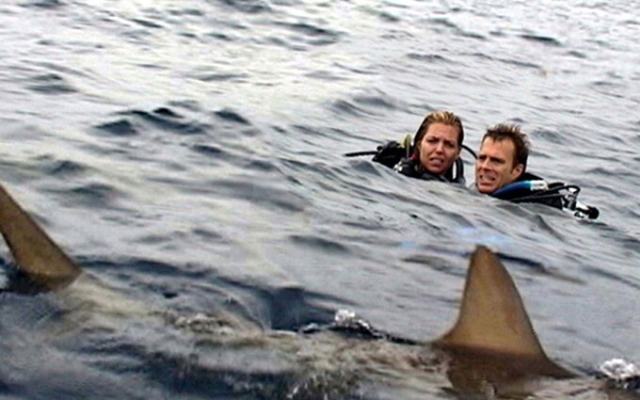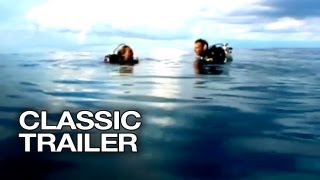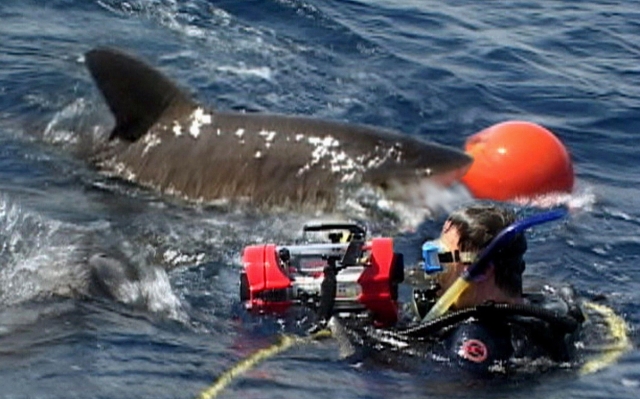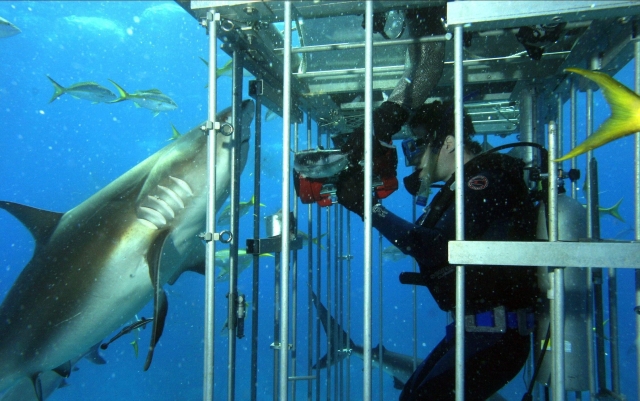 Blanchard Ryan and Daniel Travis in Open Water. Photo: Cinematic/Alamy Stock Photo
Blanchard Ryan and Daniel Travis in Open Water. Photo: Cinematic/Alamy Stock Photo
The commercially successful release of The Meg 2: The Trench confirmed one of Hollywood's longstanding tenets: that audiences really enjoy movies about basking sharks. Take the (relatively restrained) Jaws out of the equation, and some of the most ridiculous but lucrative films of the last few decades—from Renny Harlin's gleefully absurd Deep Blue Sea to the inexplicably popular Shark Tornado series—lean heavily on age-old fear. actors eaten by computer monsters somewhere in the ocean. Meg's first painting grossed an astonishing $530 million worldwide; it is quite possible that its continuation will equal if not surpass it.
However, among all the profoundly stupid films showing how terrifying monsters from the deep turn people into bouillabaisses, one film was made two decades ago that shattered all expectations and turned a fact-based storyline into an unsurpassed and visceral movie. Written and directed by Chris Kentis and produced by his wife Laura Lau, Open Water was made on a budget that wouldn't cover Meg's coffee bill, turned into a major hit, spawned two dubious sequels and became one of the most influential. horror pictures of the decade.
He played on the most primal fears of his audience — depicting a couple stranded in the water after being abandoned by an underwater expedition, with no hope of rescue and with increasingly predatory sharks approaching. It's an all-too-realistic scenario, as news reports just this week confirm: On August 14, four Australians were found clinging to their surfboards after being stranded in the middle of the ocean off the coast of Indonesia for 37 hours.
Open water proved so devastatingly effective that critic Roger Ebert was forced to say, “Rarely, sometimes a movie can have a real physical impact on you. It penetrates your defenses and bypasses the 'it's just a movie' reflex and creates a visceral sensation that could very well be true.»
The fact that Kentis and Lau used real sharks, partly to create a sense of doom and horror, and partly because the real thing was cheaper than the computer-generated effects they couldn't afford, only added to the plausibility.

The film was originally inspired by a 1998 story about an American couple, Tom and Eileen Lonergan, who went on a scuba diving trip off the coast of Australia, were accidentally abandoned by their group and were not discovered until two days later. ; their bodies were never recovered, although their diving equipment was found along with a sign on a diver's tablet that read: «To anyone who can help us: we were abandoned on A[gin]court reef by the MV Outer Edge on January 25, 1998. , 15:00. Please help save us before we die. Help!!!»
Their announcement was tragically unfortunate, but the story intrigued Kentis, who also remembered the fate of the USS Indianapolis, immortalized in a monologue in Jaws. When the ship sank in 1945, the survivors were attacked by sharks that killed countless people who were helplessly stuck in the water.
Kentis and Lau had previously starred in the low-budget romantic drama Grind, starring Billy Crudup, but it was unfamiliar territory in every way. However, as Kentis noted in a 2004 interview with IndieWire, “We knew we wanted to make a digital film around 2000, the story was in the late 90s and I knew about it then, but much more came from this. when to make a digital film. This was a turning point. Make a digital film and have full creative control, challenge yourself creatively, have the freedom to experiment and be accountable to no one.»
 Tragic: Open Water was based on the real-life disappearance of Thomas and Eileen Lonergan. Photo: AP Photo/File, XO
Tragic: Open Water was based on the real-life disappearance of Thomas and Eileen Lonergan. Photo: AP Photo/File, XO
With a total reported budget of just $120,000, but with the help of economical digital video tools, Kentis wrote the original script in just six days and then collaborated with Lau on it, coming up with something surprisingly quickly. However, he knew that no one would watch Open Water expecting witty dialogue or breakneck plot twists; instead, the film's success or failure will lie in its depiction of the most realistic shark attacks ever seen on screen.
To do this, of course, the filmmakers had to use real sharks, which they agreed to from the very beginning. As Kentis said, «Everything [usually] is done in CGI, and we wanted to try and make it more like a '70s movie when the stunt people were doing things, and we knew shooting in that format and how it was real sharks were moving, there would be no doubt in the audience that these are real things, and our actors are right there bumping into them. The lead actors, Blanchard Ryan and Daniel Travis, were not well-known faces, and they had to endure unusually many hardships.
As Ryan later recalled in an interview, Kentis informed them at the audition stage that «it's non-negotiable; there will be nudity, there will be swimming with sharks, there will be long days of swimming in the water and not many amenities, and if there is anything you are not comfortable with, we totally understand that.” However, as Ryan said, they didn't expect the film to become a hallmark of Hollywood stardom: «We were just doing a little film to get a few scenes for our (show) reel.»
 Behind the scenes at Open Water By Alami
Behind the scenes at Open Water By Alami
After they accepted the roles, filming took place in various locations. As Lau said, “We filmed in the Bahamas, we filmed in the Grenadines, we filmed in the Virgin Islands, we filmed in Mexico… we didn't want to hurt anyone's tourism. We didn't want anyone to think, «Oh, if I go to the Bahamas, I'll get hurt by sharks.» They partnered with shark expert Stuart Kove, who was also working on a very different Deep Blue Sea, and taught Ryan and Travis how to scuba dive to the standards their characters would have done.
Once they were in the water, it was with a small crew of Kentis, Lau, and her sister, and no other help; Kentis succinctly described the assembled crew as «two actors, and with the exception of two days we spent with the shark experts and a day and a half we spent with a boat filled with extras, that was it.» It was a crew of three, two actors and a boat captain.»
As promised, the filming process was not very fun. The shoot took 32 days in total, two of which — «nearly half the film's budget» — were filmed by live sharks, and it was grueling and hard work for the actors, who often had to stay in the water. during most of the shooting days, as it was too difficult to clean up with the necessary equipment.

Although the presence of sharks was, as promised, perfectly safe — otherwise the outcome of the film would have been very different — both Ryan and Travis were stung by a jellyfish, and Ryan was bitten by a barracuda. However, they claimed to have enjoyed the experience, and Travis, perhaps with a hint of bravado, stated, «I would do it again without delay.»
His enthusiasm may have had something to do with the film's rave reception at the Sundance Film Festival in January 2004, which led to distributor Lionsgate purchasing the rights to the film for $2.5 million. As Lau recalled, his blend of no-budget Blair Witch-style aesthetics and Jaws-level thrills created huge excitement among audiences after a similarly warm reception at the Hamptons Film Festival last year. “Our Sundance experience was one of those incredible fairy tale stories. Everything happened so fast that we were dizzy … we had a screening on Friday night, we had a screening on Saturday morning, and that's it, by the evening we sold our film.
It was released in August 2004 to rave reviews and proved to be extremely profitable; it grossed $30 million at the US box office and $25 million internationally, and spawned two sequels, neither of which featured Kentis or Lau, and both were unrelated to the original except for the general theme of a shark attack.
 Chris Kentis takes close-up shots of Open Water Credit: Maximum Film/Alamy Stock Photo
Chris Kentis takes close-up shots of Open Water Credit: Maximum Film/Alamy Stock Photo
Perhaps surprisingly, none of the Open Water contributors have benefited from its critical and commercial success; the only film Kentis and Lau made afterwards, 2011's Quiet House with Elizabeth Olsen, was not a hit. And Kentis subsequently downplayed the original film's marketing campaign, which emphasized themes of horror and suspense, saying, «It didn't quite fit the movie. I still see it as a drama with talking heads. It wasn't in the Jaws genre.
He also wasn't thrilled with the studio's decision to license the title for much weaker sequels. «Lionsgate called and said, 'We'll pay you some money if we can do it,'» he said. “So we went together. I saw it in the end. It's not the kind of movie I liked.»
However, in its no-budget, minimalist aesthetic, presented somewhere halfway between the Dogme 95 movement and what Spielberg could have done if had he directed Jaws using his savings, Open Water remains infinitely more frightening and effective than any number of Meg's sequels. And, as Kentis rightly said, “Whenever this genre comes up, you see our film mentioned. It's cool that we've done something meaningful enough to stay here.»
It's been two decades and it's still enough to make you think about going to the ocean.






















































Свежие комментарии